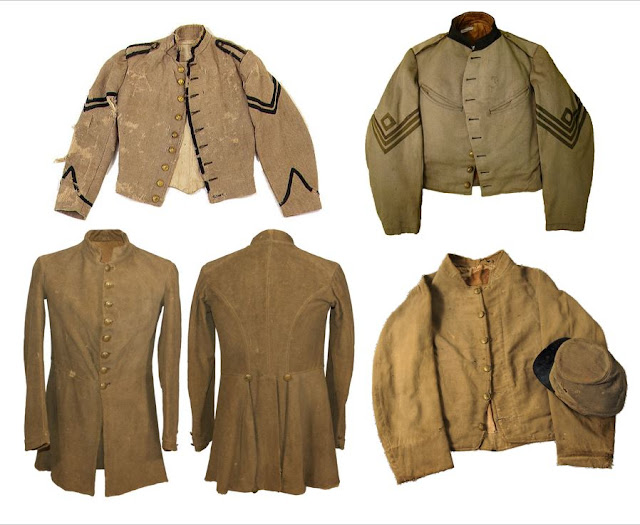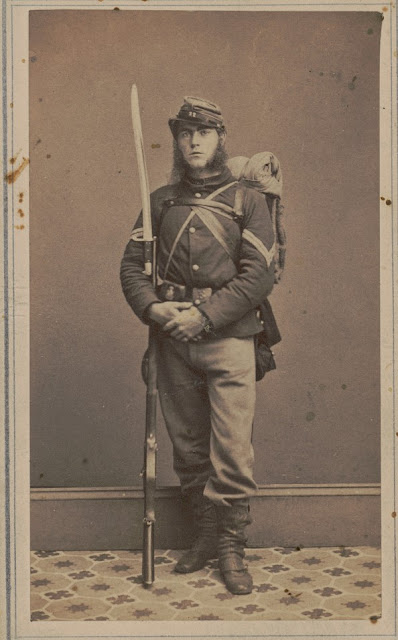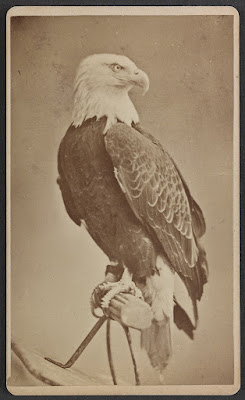Blazing Away with Our Belgian Rifles: With the 37th Illinois at Pea Ridge
In writing about the March 1862 Battle of Pea Ridge, Captain Eugene Payne of the 37th Illinois took special care to note how the men of his company fought the battle. Operating contrary to their training, the men didn't stand side by side in serried ranks; they took cover and fought while lying prone upon the ground.
"
Captain Payne’s description of Pea Ridge first saw publication in the March 29, 1862, edition of the Waukegan Weekly Gazette.
 |
| Captain Eugene B. Payne, Co. C, 37th Illinois Volunteer Infantry |
Sugar Creek, Benton Co., Arkansas
March 12, 1862
Friend
Werden,
I wish to give our friends in Lake
County a short description of our late battle with its incidents and will
direct you if you will be so kind to place the same before them by insertion in
the Gazette.
At 1 o’clock on the night of the 5th
of March, the camp of the 37th Illinois was aroused and surprised
with the news that Price was advancing upon us with a large force, that he had
had a fight with General Sigel’s advance guard, and had driven them in. Soon
the whole camp was in commotion, cooking rations for three days, and in getting
ready for a fight. We worked and waited until daylight and then found that
Price had moved to the west of us. About noon, we pulled up stakes and moved
our camp about three miles to the northward.
The boys began to think the alarm was but a scare when about
sundown the dead and wounded of General Sigel’s pickets began to arrive in
considerable numbers. We learned that the 2nd Missouri has been
ambushed and cut up badly and that Price had at one time during the day
surprised Sigel and about 700 U.S. troops with nearly 3,000 Rebels. General Sigel
fought his way back to his command and we heard that a battle would be fought
in the morning.
About the middle of the next forenoon, the 7th of
March, the battle commenced in earnest. The booming of cannons was heard at our
camp for two or three hours before our brigade was ordered into action. We
formed quietly and coolly. Marched about two miles to the little village of
Leesburg where we halted and disrobed ourselves of our knapsacks, overcoats,
and every cumbersome article about us. We formed again in line and with a yell
started for the battlefield about quarter of a mile ahead where Davidson’s
battery had already began to play upon the Rebels. This battery was placed in a
large cornfield surrounded by heavy woods, covered thickly with small red oaks,
with the dead leaves still upon them.
Leaving the battery to our left, we passed up the east side
of the cornfield nearly to its northern fence then filed off into the woods in
a northeast direction followed by the 59th Illinois until
we met the enemy’s pickets who fired and retreated back. Here we halted and lay
down while every eye was bent upon the thickets to the right and front of us.
We had not long to wait for soon the bullets and buckshot began to play upon us,
pattering the dry leaves like hail.
“We started off as if we were going to a ball or a wedding, the bands playing Dixie.” ~ Corporal Owen M. Callaghan, Co. C, 37th Illinois
Then the secesh found out where the 37th Illinois
lay. For half an hour did our brave lads pour the deadly contents of their
Belgian rifles into the enemy. Lying upon the ground our boys would load, then
turn over, get upon one knee, pick out a secesh, and blaze away. Our guns did
fearful execution as the rows and heaps of dead and dying secesh testified
afterwards in front of where our regiment lay. At this first stand of our
regiment was where we lost most of our boys. Our right wing suffered the most,
it being nearer the enemy than the left.
The enemy’s extreme left rested about 15 rods to the right
and front of our right wing then its center and right stretched off in an
almost northerly direction thus forming with our line, the letter V. On this
stand of Co. A of the 37th suffered their entire loss of killed and
wounded together with the captain. Company after company were slowly driven
back until Cos. C and D were the only ones left on the field. For full ten
minutes longer did these two companies face the music while the leaden hail
fairly plowed the ground around and among them; then, they too were obliged to
retreat to the regiment. We quickly formed again and advanced upon the enemy, driving
them to and beyond the place of our first stand.
“I got two bullets through my pants and one ball struck the metallic plate of the U.S. in the center of the belt and glanced off which saved my life- a miss is as good as a mile. The bullets flew thick and fast on both sides but we got the better of them.” ~ Private Calvin F. Boardman, Co. C, 37th Illinois
Three times that day were the noble 37th Illinois
driven back and three times did they rally to their colors and rush upon the
enemy. It was now sundown. We had fought for six long hours over a space of
ground not one-quarter of a mile wide and having driven the enemy but a little
distance beyond our first position. We lay down and slept upon the battlefield,
our pickets and those of the enemy being only about 20 rods apart. During the
night we were not disturbed. Early the next morning, we formed again and with
no breakfast, marched northward about a mile beyond the battleground of the day
before, the enemy having fallen back during the night. We took up our position
again on the right of our battery.
At sunrise the ball was opened by the artillery which did
fearful execution and continued until near the middle of the forenoon when
nearly every secesh battery being silenced or withdrawn, the line of infantry
was formed extending almost three miles in length. Our regiment occupying the
center was ordered to charge and nobly was it done. Our boys, maddened to
desperation, fought like tigers. The long line of infantry advanced at the
double quick upon the Secesh camp driving the Rebels before them like chaff
before the wind while the continued roll of musketry was fairly deafening.
We followed them until about 2 o’clock when we halted. The
Rebels were fairly routed and their camp broken up, hundreds of them prisoners,
and the balance of their army scattered over the country like frightened sheep.
The battlefield for over two miles was literally covered with their dying and
dead. Thus, the battle ended. Our victory was complete and although dearly
bought, made us rejoice for our country’s sake even while we shed the tears of
sorrow over the dead bodies of our comrades who had fallen by our sides.
The loss of the regiment is 21 killed and about 125 wounded. Of my own company, I had three killed and 19 wounded and can say that I feel proud of Co. C and every man did his duty bravely and well. Our major Charles Black was wounded badly in the arm. Colonel White and Lieutenant Colonel Barnes came off unharmed although they were in the thickest of the fight both days, nobly discharging their duty like soldiers as they are. I must now conclude. It is getting late and this mail is the only chance to send for some time.
Yours in
haste,
Captain E.B. Payne, commanding Co. C
Sources:
Letter from Captain Eugene Beuharnais Payne, Co. C, 37th Illinois Volunteer Infantry, Waukegan Weekly Gazette (Illinois), March 29, 1862, pg. 2
Letter from Corporal Owen M. Callaghan, Co. C, 37th Illinois Volunteer Infantry, Waukegan Weekly Gazette (Illinois), April 12, 1862, pg. 2
Letter from Private Calvin Fish Boardman, Co. C, 37th Illinois Volunteer Infantry, Waukegan Weekly Gazette (Illinois), March 29, 1862, pg. 3










Comments
Post a Comment